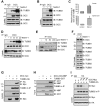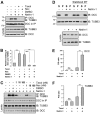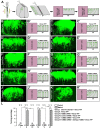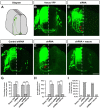Direct binding of TUBB3 with DCC couples netrin-1 signaling to intracellular microtubule dynamics in axon outgrowth and guidance
- PMID: 23641072
- PMCID: PMC3711200
- DOI: 10.1242/jcs.122184
Direct binding of TUBB3 with DCC couples netrin-1 signaling to intracellular microtubule dynamics in axon outgrowth and guidance
Abstract
The coupling of axon guidance cues, such as netrin-1, to microtubule (MT) dynamics is essential for growth cone navigation in the developing nervous system. However, whether axon guidance signaling regulates MT dynamics directly or indirectly is unclear. Here, we report that TUBB3, the most dynamic β-tubulin isoform in neurons, directly interacts with the netrin receptor DCC, and that netrin-1 induces this interaction in primary neurons. TUBB3 colocalizes with DCC in the growth cones of primary neurons and MT dynamics is required for netrin-1-promoted association of TUBB3 with DCC. Netrin-1 not only increases co-sedimentation of DCC with polymerized MT, but also promotes MT dynamics in the growth cone. Knocking down TUBB3 inhibits netrin-1-induced MT dynamics, axon outgrowth and attraction in vitro and causes defects in commissural axon projection in the embryo. These results indicate that TUBB3 directly links netrin signaling pathways to MT dynamics and plays an important role in guiding commissural axons in vivo.
Keywords: Axon guidance; DCC; Microtubule dynamics; Netrin; Signal transduction; TUBB3.
Figures








Similar articles
-
Uncoupling of UNC5C with Polymerized TUBB3 in Microtubules Mediates Netrin-1 Repulsion.J Neurosci. 2017 Jun 7;37(23):5620-5633. doi: 10.1523/JNEUROSCI.2617-16.2017. Epub 2017 May 8. J Neurosci. 2017. PMID: 28483977 Free PMC article.
-
Coordinated interaction of Down syndrome cell adhesion molecule and deleted in colorectal cancer with dynamic TUBB3 mediates Netrin-1-induced axon branching.Neuroscience. 2015 May 7;293:109-22. doi: 10.1016/j.neuroscience.2015.02.042. Epub 2015 Mar 6. Neuroscience. 2015. PMID: 25754961 Free PMC article.
-
Human TUBB3 Mutations Disrupt Netrin Attractive Signaling.Neuroscience. 2018 Mar 15;374:155-171. doi: 10.1016/j.neuroscience.2018.01.046. Epub 2018 Jan 31. Neuroscience. 2018. PMID: 29382549 Free PMC article.
-
Netrin, Slit and Wnt receptors allow axons to choose the axis of migration.Dev Biol. 2008 Nov 15;323(2):143-51. doi: 10.1016/j.ydbio.2008.08.027. Epub 2008 Sep 5. Dev Biol. 2008. PMID: 18801355 Review.
-
Netrin-4: Focus on Its Role in Axon Guidance, Tissue Stability, Angiogenesis and Tumors.Cell Mol Neurobiol. 2023 Jul;43(5):1663-1683. doi: 10.1007/s10571-022-01279-4. Epub 2022 Nov 9. Cell Mol Neurobiol. 2023. PMID: 36350538 Free PMC article. Review.
Cited by
-
Netrin-1 stimulated axon growth requires the polyglutamylase TTLL1.Front Neurosci. 2024 Oct 14;18:1436312. doi: 10.3389/fnins.2024.1436312. eCollection 2024. Front Neurosci. 2024. PMID: 39469034 Free PMC article.
-
Metformin Protects Human Induced Pluripotent Stem Cell (hiPSC)-Derived Neurons from Oxidative Damage Through Antioxidant Mechanisms.Neurotox Res. 2025 Mar 18;43(2):15. doi: 10.1007/s12640-025-00734-6. Neurotox Res. 2025. PMID: 40100475
-
A conceptual view at microtubule plus end dynamics in neuronal axons.Brain Res Bull. 2016 Sep;126(Pt 3):226-237. doi: 10.1016/j.brainresbull.2016.08.006. Epub 2016 Aug 12. Brain Res Bull. 2016. PMID: 27530065 Free PMC article. Review.
-
Transcription Factor Brn-3b Overexpression Enhances Neurite Outgrowth in PC12 Cells Under Condition of Hypoxia.Cell Mol Neurobiol. 2015 Aug;35(6):769-83. doi: 10.1007/s10571-015-0171-0. Epub 2015 Mar 19. Cell Mol Neurobiol. 2015. PMID: 25786379 Free PMC article.
-
Genetic heterogeneity in corpus callosum agenesis.Front Genet. 2022 Sep 30;13:958570. doi: 10.3389/fgene.2022.958570. eCollection 2022. Front Genet. 2022. PMID: 36246626 Free PMC article. Review.
References
-
- Alcántara S., Ruiz M., De Castro F., Soriano E., Sotelo C. (2000). Netrin 1 acts as an attractive or as a repulsive cue for distinct migrating neurons during the development of the cerebellar system. Development 127, 1359–1372 - PubMed
Publication types
MeSH terms
Substances
LinkOut - more resources
Full Text Sources
Other Literature Sources
Molecular Biology Databases

